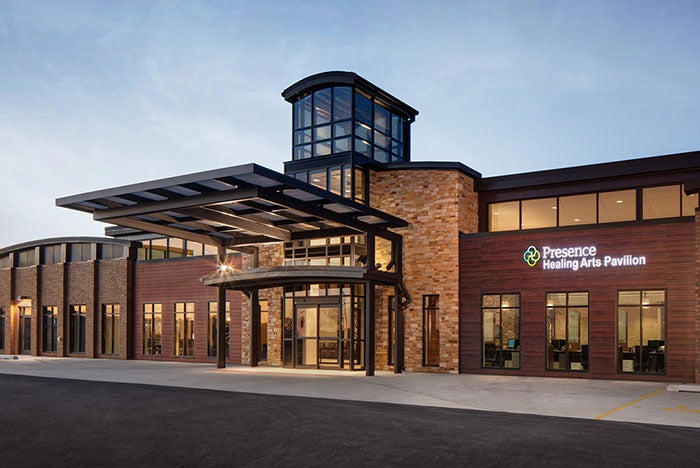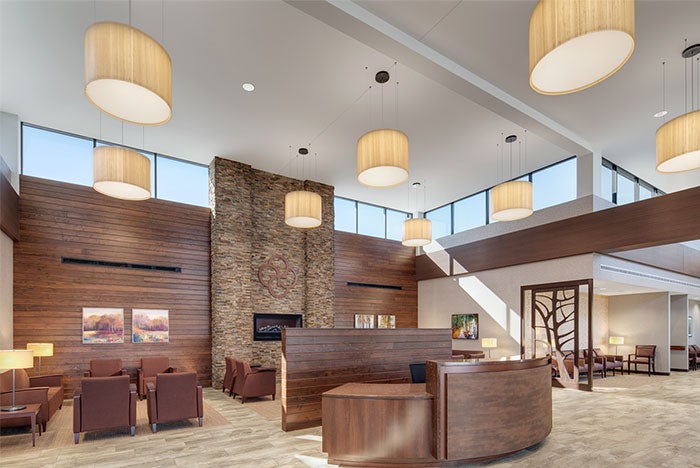Five strategies for building up an ambulatory care network

Presence Health continues to build its ambulatory care network with its recently completed Healing Arts Pavilion in Romeoville, Ill.
Implementing five key planning strategies can help health systems to create ambulatory care networks that improve patient outcomes and operate more efficiently, according to a white paper authored by the head of a leading U.S. health care project management firm.
Instead of the acute care hospital, the hub of the health delivery system will consist of a coordinated network of ambulatory care points, including, but not limited to:
- Primary care and specialty clinics
- Surgery centers
- Imaging centers and labs
- Medical office buildings
- Retail clinics
- Urgent care centers and freestanding EDs
- Telehealth facilities
Because of this fundamental change, health care leaders must create a flexible built environment that supports an effective and adaptable strategy, says Chris Kay, president and chief operating officer, Hammes Co., Brookfield, Wis.
“This ambulatory network of the future is a strategic planning model that accounts for the deep trends reshaping the health care industry, and the true center of health care delivery will soon be a coordinated network of ambulatory care points,” he says.
According to Kay, the five principles driving the new model include:
- Think beyond the primary service area
- Adopt a design-neutral approach
- Make room for virtual care
- Use predictive analytics for site selection
- Build for access and efficiency
Strategy 1: Think beyond the primary service area
The ambulatory network of the future is the hub of a care delivery system, and health care leaders must broaden their geographic focus and think beyond their existing primary service areas as a result, Kay says.

Lobby of the 30,000-square-foot Presence Health-Healing Arts Pavilion.
By thinking in terms of population health, health care systems can identify the needs of people in a region and the types of delivery solutions the network should include. Strategic partnerships and affiliations are key to assembling an effective ambulatory network, he adds.
Strategy 2. Adopt a design-neutral approach
Meeting today’s needs while also aligning with the ambulatory network of the future requires an adaptable design. This design-neutral approach ties to a flexible and operationally neutral template that adapts to new technologies, scientific advances and novel delivery processes as they evolve. The most efficient facilities must be able to accommodate geographic changes associated with an aging patient population that will require geriatric and chronic care services.
Strategy 3. Make room for virtual care
Virtual care requires a complex balance of traditional site-based care and requirements for that type of care. Virtual care will reduce or change the need for many clinical spaces, including exam rooms, as the concept gains acceptance, Kay predicts.
At the same time, the need for specialized spaces to support information technology systems, telehealth equipment and support staff will remain. Virtual care technology likely will drive the development of Lean diagnostic facilities staffed primarily by technicians and specialists who provide remote care, he says.
Strategy 4. Use predictive analytics for site selection
Predictive analytics use rich data sets to model complex consumer demand and individual behavior. These tools help leaders to understand regional patient populations and plan access points within an optimal ambulatory network. Health care providers can construct market scenario models to differentiate market opportunity by patient demand, as well as market opportunity by competitive landscape, Kay says.
Strategy 5. Build for access and efficiency
Patient-centric health care requires access and efficiency throughout the care continuum. Design and process must work in tandem to ensure easy access, short wait times and quick throughput, he says.
A hybrid medical office or clinical research building that allows physicians to add their greatest value to the ambulatory network are possible examples of achieving these objectives.
The facilities must consider technology’s impact on each phase of the health care experience starting with patient registration through evolving telehealth capabilities and more efficient physician and staff workflows, Kay says.




